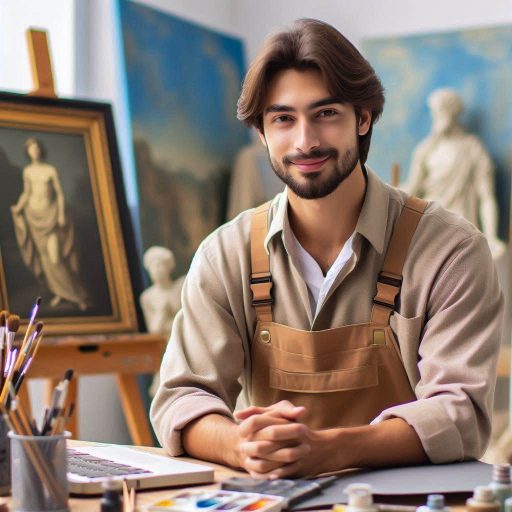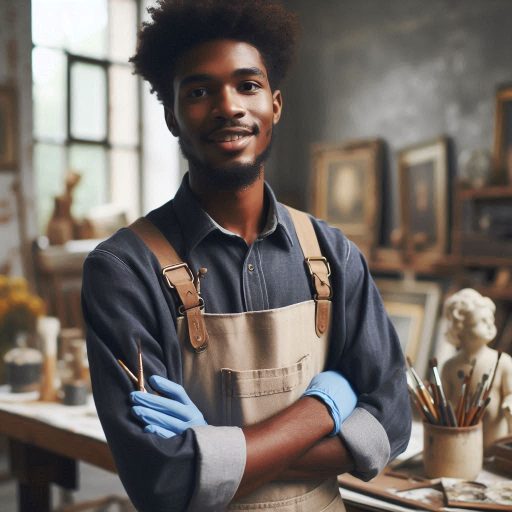Introduction
Art conservation plays a crucial role in preserving cultural heritage.
Without it, valuable artworks could deteriorate and be lost to time.
This field ensures that masterpieces from various eras remain intact for future generations.
Art conservators work meticulously to maintain the integrity of these works, from ancient manuscripts to modern paintings.
Their efforts not only protect the physical state of artworks but also help in maintaining historical and cultural contexts.
Technology has revolutionized art conservation in recent years.
It has introduced innovative methods and tools that significantly enhance conservation practices.
For example, digital imaging technologies allow conservators to analyze artworks in unprecedented detail.
Techniques such as infrared reflectography and X-ray fluorescence reveal hidden layers and materials that were previously inaccessible.
This detailed analysis helps conservators make informed decisions about treatment and restoration.
Advanced software now enables the creation of high-resolution digital archives of artworks.
These archives serve as crucial records for both current and future conservation efforts.
They allow conservators to track changes over time and compare different states of an artwork.
Moreover, virtual reality offers immersive ways to study and interact with artworks without physical contact.
This technology reduces the risk of damage during examination and provides educational opportunities for both professionals and the public.
Additionally, technology aids in developing new conservation materials and methods.
Innovative coatings and adhesives designed through technological advancements improve the longevity and effectiveness of conservation treatments.
These materials are often more compatible with original art materials, ensuring that restorations are both reversible and minimally invasive.
In summary, technology has become a game-changer in art conservation.
It enhances the precision, efficiency, and effectiveness of conservation practices, ensuring that our cultural heritage is preserved for future generations.
Transform Your Career Today
Unlock a personalized career strategy that drives real results. Get tailored advice and a roadmap designed just for you.
Start NowTraditional Methods of Art Conservation
Art conservation has evolved significantly with the advent of technology, but traditional methods laid the foundation.
Before technology’s influence, art conservation involved manual and often painstaking techniques.
How Art Conservation Was Done Before the Use of Technology
Historically, art conservation relied heavily on manual skills and methods passed down through generations.
Conservators used hand tools for cleaning and repairing artworks.
They employed natural solvents and traditional techniques to remove dirt and stains.
For canvas repairs, patching and stitching were common practices.
Pigments were matched and applied manually to restore faded areas.
Each step required meticulous attention and deep knowledge of materials and techniques.
Limitations of Traditional Methods
Traditional conservation methods, while effective to a degree, had notable limitations.
One major issue was the lack of precision.
Manual techniques often led to inconsistent results, with varying levels of success in restoration.
Traditional methods also relied on the conservator’s skill and experience, making outcomes highly subjective.
The absence of advanced diagnostic tools meant that underlying issues in artworks were not always detected, leading to incomplete or misguided interventions.
Furthermore, traditional methods often involved invasive procedures, risking further damage to the original artwork.
The restoration process was time-consuming and could not easily accommodate the complexities of modern artworks.
Overall, while traditional methods provided a foundation for art conservation, their limitations highlighted the need for technological advancements.
Technology now complements and enhances these practices, offering more precise, non-invasive, and efficient solutions for preserving our artistic heritage.
Read: Art Conservation Techniques and Best Practices
Evolution of Technology in Art Conservation
Technology has profoundly transformed art conservation, introducing new tools and techniques that enhance preservation practices.
This section explores how these advancements have evolved and their impact on conservation efficiency and accuracy.
Transform Your Career Today
Unlock a personalized career strategy that drives real results. Get tailored advice and a roadmap designed just for you.
Start NowIntroduction of New Technological Tools and Techniques
New technologies have revolutionized art conservation, providing innovative tools for analysis and restoration.
Advanced imaging techniques, such as multispectral and infrared imaging, allow conservators to view layers beneath the surface of artworks.
These methods reveal details invisible to the naked eye, aiding in the accurate assessment of an artwork’s condition.
Additionally, 3D scanning technology has become invaluable.
It creates detailed digital models of artworks, enabling conservators to study and repair pieces without direct contact.
This technology also helps in recreating damaged or missing parts with precision.
The development of chemical analysis tools has further refined conservation efforts.
Techniques like X-ray fluorescence (XRF) and gas chromatography-mass spectrometry (GC-MS) identify the composition of materials used in art.
This information is crucial for making informed decisions about the appropriate conservation treatments.
Impact of Technology in Improving the Efficiency and Accuracy of Conservation Processes
The integration of these technologies has significantly improved the efficiency of conservation processes.
Digital documentation allows for precise records of the condition and treatment of artworks.
Conservators can track changes over time and assess the effectiveness of various conservation methods.
Technology also enhances accuracy in the restoration process.
For instance, digital imaging aids in matching colors and materials, ensuring that any repairs are seamlessly integrated with the original work.
This reduces the risk of over-restoration or incorrect interventions.
Furthermore, the use of virtual reality (VR) enables conservators to simulate conservation procedures before applying them.
This virtual testing helps in predicting outcomes and selecting the best approach, thereby minimizing potential damage.
In a nutshell, technological advancements have greatly improved the field of art conservation.
New tools and techniques have enhanced both the efficiency and accuracy of conservation efforts, ensuring that cultural heritage is preserved with the utmost care.
Read: Top Museums Hiring Art Conservators/Restorers
Transform Your Career Today
Unlock a personalized career strategy that drives real results. Get tailored advice and a roadmap designed just for you.
Start Now
Use of Imaging Technology in Art Conservation
Imaging technology plays a crucial role in art conservation.
It helps in analyzing and documenting artworks with precision and clarity.
These advanced techniques provide insights that are not visible to the naked eye, allowing conservators to make informed decisions about preservation.
How Imaging Technology Is Used
Imaging technology enables detailed examination of artworks without physical contact.
It captures high-resolution images that reveal hidden layers and underlying structures.
By using various imaging methods, conservators can detect damage, evaluate the condition, and understand the artist‘s techniques and materials.
Examples of Imaging Techniques
X-rays are a fundamental tool in art conservation.
They penetrate the artwork, revealing underlying layers, previous restorations, and structural elements.
X-rays help identify issues such as cracks, paint layers, and structural damage that may not be visible on the surface.
Infrared Reflectography is another valuable technique.
It uses infrared light to penetrate through the paint layers, showing under-drawings and modifications made by the artist.
This method is particularly useful for studying the artist‘s working process and making decisions about necessary conservation interventions.
3D Scanning offers a modern approach to imaging. It creates a detailed three-dimensional model of the artwork.
This technique allows conservators to study the surface texture and dimensional changes, which is crucial for accurate restoration and preservation.
It also helps in virtual reconstruction and provides a precise record of the artwork’s condition.
In summary, imaging technology significantly enhances art conservation efforts.
Techniques like X-rays, infrared reflectography, and 3D scanning provide valuable information about artworks, ensuring their preservation for future generations.
Read: How to Start a Career in Art Conservation
Digital restoration and reconstruction
Technology has revolutionized the way art conservationists approach the restoration and reconstruction of damaged artworks.
By utilizing various digital tools and software, conservators can now digitally restore and recreate damaged pieces with incredible precision and accuracy.
Transform Your Career Today
Unlock a personalized career strategy that drives real results. Get tailored advice and a roadmap designed just for you.
Start NowHow technology is used to digitally restore damaged artworks
One of the key ways technology is used in art conservation is through the process of digital restoration.
This involves using advanced imaging techniques, such as high-resolution photography and scanning, to create detailed digital replicas of damaged artworks.
By analyzing these digital representations, conservators can identify areas of damage and deterioration more effectively than traditional methods.
This allows for a more targeted approach to restoration, minimizing the risk of further damage to the artwork.
Advantages of digital reconstruction in preserving the original aesthetic appeal of artworks
Additionally, digital reconstruction plays a vital role in preserving the original aesthetic appeal of artworks.
By utilizing 3D modeling software and other digital tools, conservators can digitally recreate missing or damaged portions of an artwork with incredible accuracy.
This ensures that the final restoration maintains the integrity and beauty of the original piece, while also providing a more comprehensive and visually pleasing result.
In essence, the impact of technology on art conservation, particularly in the realm of digital restoration and reconstruction, cannot be overstated.
By leveraging advanced imaging techniques and digital tools, conservators are able to preserve and protect artworks in ways that were once unimaginable.
This not only ensures the longevity of these cultural treasures but also allows future generations to continue to appreciate and learn from our rich artistic heritage.
Read: Essential Tools for Art Conservation and Restoration
Preventive conservation through monitoring systems
When it comes to art conservation, preventive measures play a crucial role in preserving artwork for future generations.
Technology has revolutionized the way monitoring systems are used to ensure the longevity of art pieces.
Monitoring systems are essential tools in the field of art conservation as they help in tracking environmental conditions that can potentially harm or deteriorate artwork.
These systems provide real-time data that enables conservators to take necessary actions to protect the art pieces.
How Technology is Used to Monitor Environmental Conditions
Advancements in technology have led to the development of sophisticated monitoring systems that are capable of measuring various environmental factors such as temperature, humidity, light exposure, and air quality.
These systems are often equipped with sensors that continuously monitor the conditions surrounding the artwork.
For instance, sensors can be placed in display cases or storage areas to monitor temperature and humidity levels.
If these levels exceed the recommended range, the system can send alerts to conservators, prompting them to take corrective measures such as adjusting the HVAC system or relocating the artwork to a more suitable environment.
Examples of Monitoring Systems Used in Museums and Galleries for Preventive Conservation
- Data loggers: These devices are commonly used in museums and galleries to monitor temperature and humidity levels over an extended period.
Data loggers store collected data, which can be analyzed to identify trends and patterns that may impact the artwork. - Light meters: Light exposure is a critical factor that can cause irreversible damage to artwork.
Light meters are used to measure the intensity of light in display areas and galleries to ensure that artwork is not exposed to harmful levels of light. - Particle counters: Air quality can have a significant impact on the condition of artwork, especially in spaces with high levels of pollutants.
Particle counters are used to detect and measure airborne particles that can potentially damage art pieces.
Therefore, monitoring systems powered by technology have become indispensable tools in the field of art conservation.
Transform Your Career Today
Unlock a personalized career strategy that drives real results. Get tailored advice and a roadmap designed just for you.
Start NowBy constantly monitoring environmental conditions and providing timely alerts, these systems help in preserving artwork for future generations to enjoy.
Find Out More: Crafting Compelling Visual Narratives as an Art Director
Find Out More: Behind the Scenes: The Art of Creating Stunning Sets
Challenges and criticisms of technology in art conservation
Concerns about the reliance on technology
One major criticism of technology in art conservation is the fear that it may overshadow traditional techniques.
Some experts worry that the focus on technological solutions may detract from the skill and expertise of conservators.
There is a concern that relying too heavily on technology could result in a loss of the human touch in the restoration process.
Art conservation is as much an art as a science, and the emotional connection to the artwork can be lost with excessive use of technology.
Conservators must be cautious not to let technology dominate the conservation process and instead use it as a tool.
Balancing traditional methods with technological advancements
While technology offers innovative solutions, it is crucial to maintain a balance with traditional conservation methods.
Traditional techniques have been refined over centuries and offer a deep understanding of art materials and techniques.
Conservators argue that a blend of modern technology and traditional methods can lead to more effective and nuanced results.
Combining the old with the new allows conservators to leverage the strengths of both approaches for optimal outcomes.
By integrating technology thoughtfully, conservators can enhance their work without compromising the integrity of the artwork.
Finding harmony between tradition and technology
Conservators must acknowledge the importance of tradition while embracing the advantages that technology provides.
Training programs should incorporate education on both traditional and technological approaches to foster a well-rounded skill set.
Art institutions should encourage a collaborative environment where conservators can share knowledge and experiences from both realms.
Ultimately, the goal is to honor the heritage of art while evolving with the advancements of the digital age.
By striking a balance between tradition and technology, art conservation can adapt to the contemporary landscape while preserving the essence of the past.
Conclusion
Technology has profoundly impacted art conservation, transforming the field in numerous ways.
Advanced imaging techniques have revolutionized how we study and preserve artworks.
Transform Your Career Today
Unlock a personalized career strategy that drives real results. Get tailored advice and a roadmap designed just for you.
Start NowTools like infrared reflectography and X-ray fluorescence provide detailed insights into the underlying layers of art.
This detailed analysis allows conservators to understand an artwork‘s history and condition better.
Digital documentation has become essential in art conservation.
High-resolution photographs and 3D scanning create accurate records of artworks.
These digital records help track changes over time and plan conservation strategies.
They also facilitate remote access for experts around the world, enhancing collaboration.
Moreover, technology has improved the materials and methods used in conservation.
Modern adhesives and cleaning agents are more effective and less invasive.
These innovations help preserve the integrity of the original materials while ensuring long-lasting results.
However, the field of art conservation must continually innovate and adapt.
As technology evolves, so do the challenges and opportunities in conservation.
New techniques and tools emerge, requiring conservators to stay updated and skilled.
This ongoing advancement ensures that conservation practices remain effective and relevant.
In the end, technology has made a significant impact on art conservation, enhancing our ability to preserve and understand artworks.
The integration of advanced tools and methods has led to remarkable improvements in conservation practices.
Nonetheless, the field must embrace continual innovation and adaptation to address future challenges and opportunities.
This commitment to progress ensures the preservation of art for future generations while advancing our understanding of cultural heritage.




